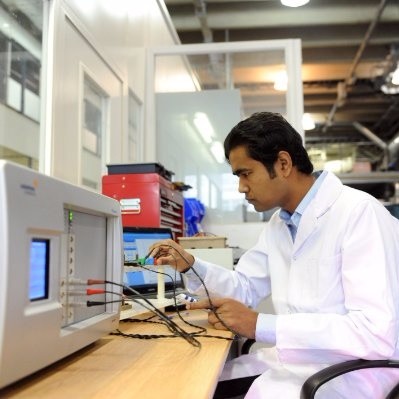WMG News
Warwick Submarine students compete at international engineering competition
The Warwick Submarine team, which consists of seven 4th year engineering students at the University of Warwick, has successfully completed the European International Submarine Races (eISR-22) in Gosport.
Races (eISR-22) in Gosport.
The student team raced their human powered submarine, against other science and marine engineering students from across the world. The submarine, named Godiva picked up two awards – the ‘Winner Day 5’ and a new award for best ‘Communication.’
The team was able to complete the whole slalom course at the Ocean Basin, and record a very respectable time of three minutes and 56 seconds. This is the first time that Godiva has achieved this since its very first entry at ISR in the USA in 2014. This impressive progress led to Godiva receiving the ‘Winner Day 5’ recognition.
The ‘Communication’ prize was judged by a group of school children who attended the races and met with the competitors. The children felt that the Warwick Sub team were the best at explaining the complexities of the project and notably without ‘talking-down’ to them.
The Warwick Submarine Academic Supervisor at WMG, University of Warwick, Professor Ian Tuersley, said: “The students were a real credit to the University, and their performance as practical engineers was very impressive”.
“The competition invariably involves a great deal of on-the-spot problem solving. Every single member of our team contributed handsomely to this effort by identifying the issues, generating innovative solutions, and then implementing them with only the barest of workshop resources to hand.”
In preparation for the competition, the students had access to cutting-edge engineering research and facilities at WMG at the University of Warwick, as well as funding from the High Value Manufacturing Catapult and help from sponsors.
Professor David Greenwood, CEO of the High Value Manufacturing Catapult, at WMG, University of Warwick, explained: “Well done to this year’s team on their achievements at e-ISR-22. We are now beginning the planning process for next year’s competition, and are looking forward to supporting a new group of students as they look to design and manufacture a new hull from composite materials. With the help of our team, they will gain indispensable hands-on practical engineering skills, at our world leading facilities.”
After arriving back from eISR-22 there was more good news for the team, as they were announced as winners of the inaugural Warwick Award for Public and Community Engagement (WAPCE), by the Warwick Institute for Engagement (WIE).
Professor Tuersley added: “It’s another fantastic achievement and provides further evidence of the team’s commitment to outreach and engagement activities.”
Find out more about the University’s student projects here.
WMG launches new sustainable elastomer research facility
WMG, at the University of Warwick, has launched its new sustainable elastomer research facility based in the International Institute for Nanocomposites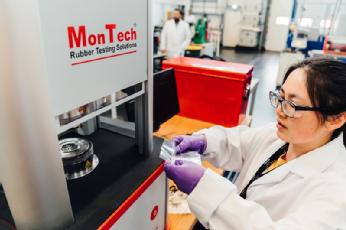 Manufacturing (IINM).
Manufacturing (IINM).
High performance elastomers are essential components in applications across a range of critical sectors, most notably for vehicle tyres, but also for footwear, soft robotics and automation.
However, the high durability of conventional rubbers also results in them being extremely difficult to recycle at the end of their service life, with many simply being incinerated and buried in landfills. The need for new and sustainable elastomer technology is becoming more urgent as society transitions towards fully electric vehicles, which are currently heavier and can cause tyre wear up to 30% faster. Tyre wear emission is accumulated as the second largest microplastics pollution globally.
The main scientific focus of the new facility is to bring together state-of-the-art research from across rubber composite processing and synthetic polymer chemistry - including manufacturing technology, multiscale characterisation, and prototype sustainable rubber products.
Capabilities within the facility include a twin-roll mill for rubber compounding; automated compression moulding and moving die rheometer (MDR); abrasion testing; and a new dynamic rubber process analyser (RPA), which enables advanced analysis of rubber networks over a temperature range of -40 °C to 232 °C, and a wide frequency range, as well as unique rheological characterisation at large amplitude oscillatory shear (LAOS).
Within the IINM there is also a wet chemistry laboratory designed for new formulation development, and rubber and nanoparticle functionalisation, as well as polymer characterisation and testing laboratories to support sustainable elastomer research and development.
Dr Chaoying Wan, Reader of Functional Polymers and Nanocomposites at WMG, University of Warwick explains: “Our new RPA has the capacity of a wider temperature range - it is the only one in the UK, and one of only a few in the world. This function is extremely useful for evaluating elastomer materials as well as for advanced scientific analysis. With support from the High Value Manufacturing Catapult, we are excited to be furthering our research towards extending the functionality of rubber materials and making the products recyclable and sustainable at end-of-life.”
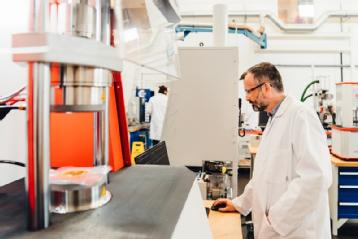 Projects currently underway in the new facility include integrating self-healing properties which result in improved safety and extended lifespan for tyres; stretchable sensors; and investigating other rubber products to enhance the durability of rubbers by the addition of nanofillers, including graphene, and recycling of rubbers for road and pavement uses.
Projects currently underway in the new facility include integrating self-healing properties which result in improved safety and extended lifespan for tyres; stretchable sensors; and investigating other rubber products to enhance the durability of rubbers by the addition of nanofillers, including graphene, and recycling of rubbers for road and pavement uses.
Find out more about WMG’s Nanocomposites research here: Nanocomposites (warwick.ac.uk)
Contacts:
Dr Chaoying Wan – Rubber Chemistry and Dielectric Elastomer Technology
Professor Tony McNally - Composites of Elastomers and Nanomaterials
UK Government awards £9.5m to British consortium to build world first advanced electric flight ecosystem
- New consortium of leading British aviation companies awarded government funding to demonstrate the commercial and operational viability of Advanced Air Mobility (AAM)
- First-of-a-kind ecosystem will accelerate introduction of AAM in the UK
- Demonstration of urban and cross-country flights planned at London Heathrow, Bristol, London City airports and a new vertiport at a London General Aviation (GA) airport
Vertical Aerospace, Virgin Atlantic, Atkins, Skyports and NATS, along with Connected Places Catapult and leading academic institutions Cranfield University and WMG, University of Warwick, today announced the creation of the Advanced Mobility Ecosystem Consortium. Together, the organisations will develop key technology and infrastructure in a project that will significantly accelerate the introduction of AAM in the UK.
The Consortium has been awarded a £9.5 million grant by the UK Government’s Future Flight Challenge to develop the essential building blocks of a viable AAM ecosystem that has the potential to be progressed into full commercial operations. This first-of-a-kind ecosystem will accelerate AAM in the UK by creating and testing technological developments in aircraft electrification, airspace management, ground infrastructure, operational procedures and the systems and supporting business cases required to implement a new model of aerial passenger transport in the UK.
Accelerating AAM
The project will demonstrate the feasibility of a UK AAM ecosystem using Vertical Aerospace’s emission-free VX4 eVTOL aircraft, operated by Virgin Atlantic. Two physical flights will take place between Bristol Airport to an airfield in South West England, and between London Heathrow Airport and the Living Lab vertiport. A third simulation flight will demonstrate urban connectivity between London City and Bristol airports.
These demonstrations will explore key aspects of the passenger journey, vehicle operation, airspace navigation, ground charging, security provision and local stakeholder engagement. Heathrow Airport, Bristol Airport, Skyports and NATS, the UK’s national air navigation service provider, will collaborate to deliver the physical and digital infrastructure to facilitate these missions through a complex airspace environment. The two-year project will be overseen by aerospace engineering experts Atkins as consortium lead.
Benefits of Advanced Air Mobility
AAM offers a new form of travel, enabling cost-effective connectivity into congested urban areas and across regions under-served by existing infrastructure. The UK Government Future Flight Challenge forecast that the introduction of AAM services will increase UK GDP by 1.8% by 2030 and support the government’s Levelling Up and Net Zero agendas, reflecting the productivity and wider economic benefits of increased connectivity.
James Richmond, Head of Advanced Air Mobility at Atkins, said: “This is an exciting leap forward for AAM. This project brings together experts from across the industry to maintain the UK’s leading position in the future of aviation, moving us closer to commercial operations that will connect regions and contribute to the UK’s net zero targets.”
Professor David Greenwood, CEO of the High Value Manufacturing Catapult at WMG, added: This project, created by a major consortium of aviation leaders, will really push forward the boundaries of developing and proving commercial eVTOL flights by demonstrating in a real-time, operational AAM ecosystem testbed. WMG is delighted to be contributing to a project which will help the UK aviation industry meet its net zero carbon goals.”
Other nations are racing to establish their own AAM ecosystems by 2025 – this project ensures the UK will be amongst the leaders in this new decarbonised form of transport. Gary Cutts, Future Flight Challenge Director at UK Research and Innovation said: “our roadmap sets out how air taxis could be in use in the UK by 2030, but a lot needs to occur for that to happen. By bringing technical developments from across the aviation industry together into one network, and undertaking early demonstration in the real-world, the Advanced Mobility Ecosystem Consortium could accelerate the timescale for AAM introduction by years. This project could revolutionise travel, not just in the UK but around the world.”
Novel Infrastructure
Skyports will build and operate a “Living Lab” vertiport to create a testbed for ground, passenger and air operations for the project duration. This centre of innovation will help to materially accelerate the development of AAM services and establish the UK as a leader in the design and operation of vertiport infrastructure.
Duncan Walker, CEO of Skyports, said: “Just as airports are critical to commercial aeroplane travel, vertiports are critical to AAM. Our Living Lab will be a central component of the consortium, enabling Skyports and partners to demonstrate end-to-end operations and test the complexities of developing a commercially viable AAM network in the UK.”
New Regional Air Connectivity
Holly Boyd-Boland, VP Corporate Development at Virgin Atlantic, said: “We are thrilled to be working alongside our consortium partners to accelerate the introduction of zero emission flight to UK customers. As the only airline in the consortium, Virgin Atlantic brings 38 years of operational excellence, a relentless focus on safety and security, and an unrivalled focus on the end-to-end customer journey. Alongside our partners, we are looking forward to getting the first Virgin Atlantic eVTOL aircraft into the skies.”
Andrew Macmillan, Director of Strategy of Vertical Aerospace, said: “Vertical is not flying solo. We are building the best industrial and commercial partner ecosystems and are progressing in Britain with our UK launch customer, Virgin Atlantic. We want the UK to lead the electric aviation and AAM revolution. This consortium will help prove how we can deliver safer, cleaner and quieter air travel with the VX4.”
A focus on integration
Atkins will lead the consortium and is responsible for technical management and integration of the two-year programme as it moves AAM from concept stage towards implementation. It will leverage its decades of aviation expertise to oversee the systems architecture and deliver a digitally enabled passenger journey management tool for infrastructure and flight operators.
For further information on WMG's research in this area, visit: https://warwick.ac.uk/fac/sci/wmg/business/transportelec/
*The full Advanced Mobility Ecosystem Consortium comprises Atkins; Vertical Aerospace; Skyports; Virgin Atlantic; Heathrow Airport; London City Airport; Bristol Airport; NATS; Cranfield University; WMG, at the University of Warwick; Connected Places Catapult; with support from EVE Air Mobility.
Young engineers hit the headlines with Design & Make triumph
Three schools from the Black Country and Warwickshire have been crowned as the main winners at one of the biggest independent manufacturing-education events in the UK.
Ernesford Grange Community Academy, Great Wyrley Academy and WMG Academy for Young Engineers Coventry beat off competition from five other rivals to take the Manufacturing,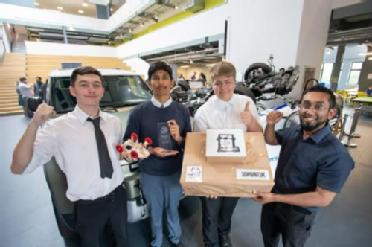 Innovation and Efficiency titles respectively at the Design & Make Challenge 2022.
Innovation and Efficiency titles respectively at the Design & Make Challenge 2022.
The trio were joined on the podium by Alcester Grammar School, who claimed the first ever ‘Communications’ prize for its use of social media in promoting the day.
Organised by the Manufacturing Assembly Network (MAN), more than 35 students swapped their daily lessons for the chance to test out their design, engineering, prototyping and communication skills at the all-day event held at WMG Academy for Young Engineers in Solihull.
Teams of four Year 11 and Year 12 pupils were set the challenge of using basic materials and tools to make a vehicle that could be propelled by a falling weight. They tested their devices, modified them and then raced them on a purpose-built 7.5m long track to see which one would complete the distance in the fastest possible time – a race that WMG Academy Coventry won in just 3.64 seconds.
“Now, more than ever, we need young people to choose engineering and manufacturing as a career and we’re not going to change perceptions by sitting on our hands, doing nothing,” explained Austin Owens, founder of Grove Design (Pembridge) Ltd and Co-Chair of the Manufacturing Assembly Network.
“This was a comeback for the Design & Make Challenge after a Covid-19 enforced break and we were delighted to see the appetite to take part was still there. I have to say the task was the hardest yet and the young people really embraced it.”
He went on to add: “The atmosphere in the room was amazing and I’m convinced we’ve seen some of the engineers of the future here, engineers that will go on and improve the way we live for the better.”
Ernesford Grange Community Academy, Great Wyrley Academy and WMG Academy Coventry all received a 3D printer for their efforts.
This latest technology was kindly donated by 3DPRINTUK, who are specialists in low volume production using state-of-the-art powder bed fusion 3D printing systems with polymer materials.
Nick Allen, Managing Director of 3DPRINTUK, commented: “We are both proud and delighted to sponsor the Design & Make Challenge 2022.
“The competition is a great fit for us. By donating 3D printers to the winners, it allows the next generation of engineers and manufacturers to learn in a hands-on way about the advantages - and disadvantages - of 3D printing for any given application. It’s something we are passionate about both now and for the future.”
Joining Alcester Grammar School, Ernesford Grange Community Academy, Great Wyrley Academy and WMG Academy Coventry at the Design & Make day were Gospel Oak School, Lawrence Sheriff School, Southam College and WMG Academy Solihull.
Peter Davies, Chief Executive of James Lister & Sons and Co-Chair of the Manufacturing Assembly Network, added his support: “The day is all about bringing sound design and engineering principles to the fore to solve a topical industrial issue, with young people encouraged to work together to develop innovative designs and then build a product they can test against their peers.
“Apprentices from MAN companies and graduates from WMG at the University of Warwick, were working with the groups and talking about their own experiences following a career in manufacturing and some of the skills they may need to realise their ambition.
“All the feedback we received was positive, which excites us about doing it again next year. We now urge other manufacturers to look at how they can play a role in helping promote our sector to young people.”
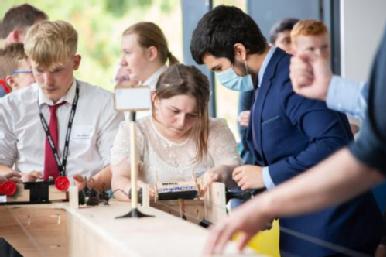 Dr Mark Swift, Head of SME Programmes at WMG at the University of Warwick, concluded: “Design & Make is a wonderful example of how to inspire future engineers - making it real and helping to bridge the skills gap, particularly in small manufacturing and engineering businesses.
Dr Mark Swift, Head of SME Programmes at WMG at the University of Warwick, concluded: “Design & Make is a wonderful example of how to inspire future engineers - making it real and helping to bridge the skills gap, particularly in small manufacturing and engineering businesses.
“SMEs are the lifeblood of manufacturing in the UK, and they offer a wonderful, rich, challenging and rewarding destination for the next generation of engineers. They get access to all parts of the business, from working with customers and suppliers to the management team and gaining experience on the shop floor – all of this will accelerate their future career.”
About the Manufacturing Assembly Network
Formed in 2006, The Manufacturing Assembly Network is made up of Alucast, Barkley Plastics, Brandauer, Grove Design, James Lister & Sons, KimberMills International, Muller Holdings, Nemco and PP Control & Automation.
The eight sub-contract manufacturers and specialist engineering design agency form a unique global collective that works together to share best practice and secure contracts for UK industry.
It is the third year that the group has held the Design & Make Challenge and earlier competitions have resulted in 352 hours of hands-on manufacturing experience for young people, seven MAN company visits completed by schools and over £25,000 of press coverage to raise the profile of the sector.
More details on MAN can be found at www.man-group.co.uk or follow MAN Group on LinkedIn.
Specialist electric motorcycle project hailed a great success
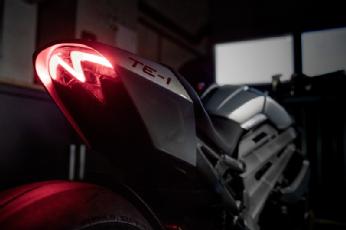 Today (Tuesday 12th July 2022), marks the official completion of the Triumph TE-1 electric development project, a unique four-way partnership between WMG at the University of Warwick, Triumph Motorcycles, Williams Advanced Engineering and Integral Powertrain Ltd e-Drive Division.
Today (Tuesday 12th July 2022), marks the official completion of the Triumph TE-1 electric development project, a unique four-way partnership between WMG at the University of Warwick, Triumph Motorcycles, Williams Advanced Engineering and Integral Powertrain Ltd e-Drive Division.
The TE-1 project was funded by the Office for Zero Emission Vehicles through Innovate UK, and was set up to create ground-breaking developments in specialist electric motorcycle engineering and innovative integrated technology design. The project provides an input into Triumph’s future electric motorcycle offering, driving innovation, new standards, capability, and new intellectual property, whilst enhancing the credibility and profile of British industry and design.
Driving lower environmental impact transportation, and delivering against the UK’s focus on reducing emissions, the project also aimed to develop strong, commercially viable and sustainable partnerships with UK industry manufacturers and supply chains, whilst building expertise and capability within the UK workforce.
Nick Bloor, CEO, Triumph Motorcycles, said: “We are incredibly proud to be able to share such positive outcomes from the completion of Project Triumph TE‑1, where the prototype demonstrator has exceeded many of our initial targets and expectations. Everyone on the team is thrilled with the results we have achieved with our partners, and how the outcomes of the project will feed into the electric future to come from Triumph.”
Released today, the final testing results show how the TE-1 prototype has delivered on all targets and objectives following an extensive live testing programme which involved numerous assessments of the bike’s performance on a rolling road as well as on track.
WMG’s role in the project was to provide electrification expertise, and the critical vision to drive innovation from R&D to commercial impact, through modelling and simulation based on future market needs.
Highlights from the testing results include a standing start acceleration of 0-60mph in 3.6 seconds, peak power of 130kW (177PS / 175bhp) as well as peak torque of 109Nm (80 lb-ft), a 20-minute charge time (0-80%) and a 161km / 100-mile range based on official testing and projections. At 220kg (485 lb), the TE-1 prototype is also lighter than the equivalent electric bikes available currently by up to 25%.
20-minute charge time (0-80%) and a 161km / 100-mile range based on official testing and projections. At 220kg (485 lb), the TE-1 prototype is also lighter than the equivalent electric bikes available currently by up to 25%.
Professor David Greenwood, CEO of the High Value Manufacturing Catapult at WMG, University of Warwick, explained: “To meet our ambitious emission reduction targets in the UK we will have to rethink the way we travel, not only transitioning from ICE to electric propulsion vehicles, but also encouraging a modal shift away from private cars. Electric two wheelers have a pivotal role to play in the transport revolution as a zero-tailpipe emission option.
“In our partnership with Triumph, WMG used our research experience in electrification to demonstrate manufacturers can deliver products with a lower emission burden as well as outstanding performance-offering customers an EV that is great fun to ride.”
Read more about WMG’s Transport Electrification research here: Energy (warwick.ac.uk)
UK closer to net-zero steel thanks to new WMG and Tata Steel partnership
More sustainable, low-carbon steel and electric vehicle batteries are the target of a new two-year technology development programme between WMG at the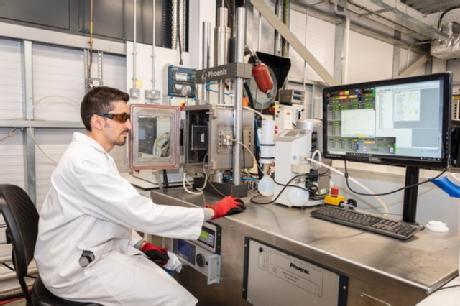 University of Warwick and Tata Steel, as part of the High Value Manufacturing Catapult.
University of Warwick and Tata Steel, as part of the High Value Manufacturing Catapult.
The two major partners will come together to focus on developing new environmentally-friendly steel grades, coatings, films, and battery structures – enabling the growth of steel application across key industrial sectors as the UK advances towards a net-zero future.
This partnership builds on the long-standing relationship between both parties and will see them collaborate to make steel cleaner, greener and more responsive to the fast-changing needs of customers across a variety of sectors.
Researchers, led by Professor Claire Davis, at WMG, University of Warwick, will be working alongside experts at Tata Steel in the UK to translate and apply outputs from the early-stage research across key UK manufacturing priority areas including advanced materials and light-weighting, electrified propulsion system applications, digital manufacturing and net-zero manufacturing including circular supply chains.
The initial research activity will be focused across five core themes: Product metallurgy; Surface state optimisation; Non-metallic coatings; Future material applications and Material forming/joining and associated characterisation.
Professor David Greenwood, CEO of the High Value Manufacturing Catapult at WMG, University of Warwick, explained, “WMG has worked with Tata Steel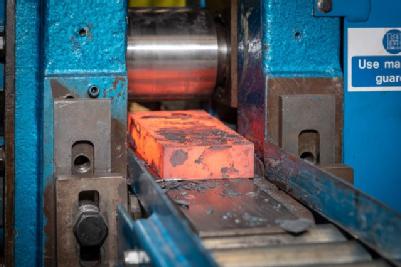 on projects for many years, and this partnership will see the collaboration grow across key research themes, including decarbonising the supply chain and enabling future applications of steel across zero carbon propulsion systems and transport vehicles. This activity will include identifying new collaborative relationships and developing world-class technology for the future of the UK steel industry.”
on projects for many years, and this partnership will see the collaboration grow across key research themes, including decarbonising the supply chain and enabling future applications of steel across zero carbon propulsion systems and transport vehicles. This activity will include identifying new collaborative relationships and developing world-class technology for the future of the UK steel industry.”
Dr. Sumitesh Das, Director of R&D, Tata Steel, explained: “This is a critical partnership for us to help support new product development with low carbon footprints across various market segments. It also strengthens our ongoing work including building technology capability and expertise in the UK in manufacturing.”
-ENDS-
Notes to Editors
Press Contacts:
Simmie Korotane. Media Relations, University of Warwick, Email: mailto: Simmie.korotane@warwick.ac.uk
Tim Rutter, Head of Public Relations, Tata Steel UK, M: +44 (0)7850 990755, E: mailto: tim.rutter@tatasteeleurope.com
Battery tech pioneer Britishvolt strengthens partnership with WMG, University of Warwick, to ramp up UK electric vehicle battery production
- The multi-million-pound [£] project with WMG, University of Warwick, is pioneering battery technology in the UK
- Research from WMG, University of Warwick, will help Britishvolt to ramp up the availability of batteries for electric vehicles, and other applications, in the UK and beyond
- The project is accelerating Britishvolt’s business plan to deliver a 38GWh battery Gigaplant, one of the largest industrial investments ever undertaken in the UK
- Britishvolt recently announced exciting plans for a scale-up production centre in the epicentre of the automotive industry located at Hams Hall, West Midlands, creating what it calls a “Battery Corridor” – linking the Northumberland site with the UK’s automotive heartland
- The Gigaplant will build enough cells each year for well over 300,000 electric vehicle battery packs, equivalent to [c]25% of current UK vehicle manufacture, securing Global Britain’s position on the sustainable battery production map
WMG has partnered with leading sustainable, low-carbon battery manufacturer, Britishvolt on a two-year multi-million-pound project which is pioneering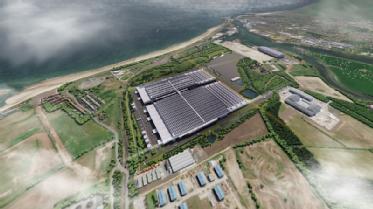 battery technology in the UK.
battery technology in the UK.
More batteries for electric vehicles will become available in the UK thanks to research from WMG, at the University of Warwick and its partnership with battery tech pioneer Britishvolt.
The project is helping Britishvolt to deliver a 38GWh battery Gigaplant, one of the largest industrial investments ever undertaken in the UK. The facility, located in the North-East of England, will quickly increase the availability of batteries required at commercial scale for the electric vehicle market – playing a key role in helping the UK reach its carbon net zero target by 2050.
Following an initial 12-month project, Britishvolt and WMG are now embarking on a two-year programme of work. WMG’s research will assist with battery cell development and optimisation including small-scale manufacturing to produce battery electrodes and cells using Britishvolt target materials sets, formulations and cell designs. These will then be tested according to Britishvolt’s agreed protocols.
Professor Dave Greenwood, CEO of the High Value Manufacturing Catapult at WMG commented: “WMG is delighted to be supporting Britishvolt as they set up large scale battery manufacturing and research facilities in the UK. This industry will be critical for the future of the UK automotive and energy sectors. WMG has been investing over the last decade in the research and development capabilities needed to help Britishvolt and other battery companies to be internationally competitive now and in the future”
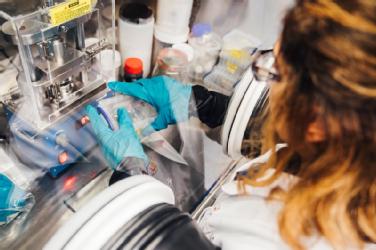 Dr Allan Paterson, Chief Technical Officer, Britishvolt, concluded: “Britishvolt are delighted to extend and expand our relationship and programme of work with WMG. The battery science, advanced materials and cell prototyping expertise and capability at WMG has directly, and positively, supported our battery technology development programme. This gives us not only an excellent basis to progress from, as we seek to scale and commercialise our technologies, but the relationship also enables Britishvolt to continue to develop our products further, as we continually strive to deliver best-in-class, market-leading, cell technologies to our customers.”
Dr Allan Paterson, Chief Technical Officer, Britishvolt, concluded: “Britishvolt are delighted to extend and expand our relationship and programme of work with WMG. The battery science, advanced materials and cell prototyping expertise and capability at WMG has directly, and positively, supported our battery technology development programme. This gives us not only an excellent basis to progress from, as we seek to scale and commercialise our technologies, but the relationship also enables Britishvolt to continue to develop our products further, as we continually strive to deliver best-in-class, market-leading, cell technologies to our customers.”
Britishvolt: Power with Purpose
The Northumberland Gigaplant – Britishvolt’s first large, full-cycle Gigaplant in the UK - will have a total capacity of over 38 Gigawatt Hours by the end of the decade and will produce enough cells far in excess of 300,000 electric vehicle battery packs per year, intended primarily for use in the automotive industry. The development is a major boost for Northumberland, and the UK, delivering around 3,000 direct skilled jobs and another 5,000-plus in the associated supply chains.
Britishvolt’s collaborations with academia, industry and private enterprise will also help transition the UK from fossil fuels to a low carbon, battery-based electric future.
The release of an official A-sample battery cell to customers, which is scheduled later in 2022, will help to further accelerate commitments.
Britishvolt recently announced that it will develop its UK battery cell scale-up facility in the West Midlands, home to the internationally renowned battery ecosystem With a budget exceeding £200m, the plan looks to create upwards of 150 highly skilled, well-paid jobs; unifying the Britishvolt Northumberland Gigaplant with a centrally located scale-up/technology hub
The Hams Hall site will spearhead new cell formats and electro chemistries to create higher performance, production ready, batteries of the future whilst helping lower cell costs for more affordable EVs, aiding mass adoption
Britishvolt is one of the fastest growing battery technology companies in Europe and globally. The company is also in discussions with the Canadian Government regarding its expansion plans in the country.
Watch Britishvolt’s Battery Research video: https://www.youtube.com/watch?v=3UlDcUjMhiE
WMG supports Norton Motorcycles as they announce plan to build electric motorcycles in the UK
WMG, at the University of Warwick, is supporting Norton Motorcycles in its intention to begin developing electric motorcycles in the UK after winning significant investment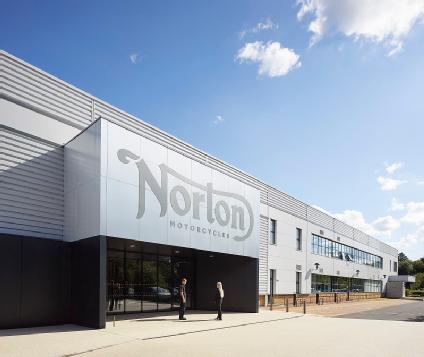 through a government scheme.
through a government scheme.
The iconic British motorcycle brand has been awarded funding by Advanced Propulsion Centre (APC) 19, an initiative which aims to assist businesses in the automotive sector in advancing their low-carbon offering while helping to accelerate the UK towards a net-zero automotive future, a future that Norton fully embraces.
As demand for electric motorcycles and micro-mobility solutions grow, the project, Zero Emission Norton, will expand Norton’s ever-growing electric vehicle engineering capabilities and develop world class electric motorcycles.
To deliver this ambitious project, Norton will work with specialist project partners who have the same vision for innovation in production of world-class electric motorcycles. The team encompasses Delta Cosworth, HiSpeed Limited, Formaplex Technologies, M&I Materials, INDRA and academic partner WMG at the University of Warwick.
Each partner on the project will have a specialist part to play in project Zero Emission Norton. Delta Cosworth will design the battery pack, while HiSpeed Limited bring motor design and manufacturing skills. Formaplex Technologies have expertise in precision composites manufacturing and M&I Materials will support on applications of dielectric cooling oils. INDRA specialise in vehicle to home charging technology and WMG major on battery technology, modelling and toolchain development.
Norton will work alongside these partners to develop world-class technology and products that will enhance the UK supply chain for all the critical components in electric vehicle (EV) technology including batteries, motors, chassis, cooling oils and vehicle to home chargers.
As a result, the 30-month project is expected to create a significant number of jobs in the UK in manufacturing and R&D as well as upskilling existing staff to be capable of electric motorcycle engineering. This in turn will help address the UK skills shortfall in that space while returning the UK to the position it last enjoyed in the 60’s, as the global technology leader for motorcycles.
Andrew McGordon, Reader, Energy Applications Group at WMG, University of Warwick, said: “WMG is excited to be a partner in this project exploiting our research in battery and systems modelling to develop a zero-prototype modelling and validation methodology, including predictive smart charging and Vehicle to Grid technology. We will bring extensive electrification experience to this project having worked across many sectors already.”
Robert Hentschel, CEO Norton Motorcycles commented: “This significant funding investment is a momentous milestone for the brand as it marks the beginning of our electrification journey and fulfilling our ten-year product plan.Norton is an exemplar of modern luxury and unafraid to challenge the status quo, innovating for the future of mobility while staying true to our British heritage. It also brings into focus our desire to support the UK in its mission for a net-zero automotive future.
“Working alongside our world class partners, we’re confident that project Zero Emission Norton will eliminate the current dispute between a conventional and electric motorcycle to create EV products that riders desire – motorcycles that blends Norton’s uncompromising design DNA with racing performance, touring range and lightweight handling.”
Ian Constance, Chief Executive of the APC said: "The projects receiving today’s investment highlight the breadth of technologies needed to help the UK accelerate to net zero emissions. They’re reimagining not just vehicles, but transport in general.
"Norton are an iconic British brand with a proud history. From making motorcycles to support the second world war effort to developing the world’s first production superbike, they are now looking to the future with an electric bike that will deliver both performance and range radiating from a UK manufacturing base and strengthening highly-skilled jobs and green growth."
Ends
For any enquiries, please contact Stephanie Staff at Performance Communications on
07798 897 692 or email norton@performancecomms.com
Website: www.nortonmotorcycles.com
Carbon, cost and battery conditioning benefits calculated for vehicle-to-grid chargepoints
Vehicle-to-grid chargepoints can improve battery life in electric vehicles and reduce carbon emissions and costs of charging, a government-funded project has found.
Research from the EV-elocity project shows that, by careful charging and discharging, EV battery degradation can reduce by one-eighth, and, in some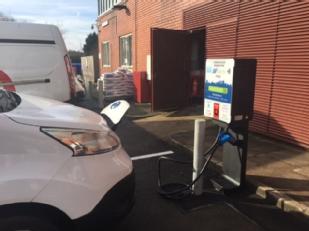 situations, up to 450 kg of emitted carbon dioxide (CO2) or £400 could be saved per vehicle each year.
situations, up to 450 kg of emitted carbon dioxide (CO2) or £400 could be saved per vehicle each year.
Vehicle-to-grid (V2G) can balance the calendar and cycling aging (both of which affect the rate of battery degradation) to optimise the battery condition and improve its health by 8.6 – 12.3% over one-year’s operation, compared to conventional charging alone - equivalent to one extra year of use.
In cost-terms, V2G tariff optimisation can save around £100 per year per charge point on normal business electricity tariffs, with up to £400 saved on a smarter tariff.
If managed to maximise the environmental benefit, nearly half a tonne of annual CO2 emissions can be saved, and significant savings (over 180 kg) can be made even when reducing cost is the main goal.
Chris Rimmer, Infrastructure Strategy lead at Cenex and the project’s lead project manager, said: “Our conclusions show that it is not necessary to trade-off financial, environmental and asset lifetimes when charging Electric Vehicles. Cost, carbon, and conditioning benefits can all be gained when V2G is used intelligently with fleet vehicles.”
Professor Lucelia Rodrigues of the University of Nottingham added “a key challenge for an optimum application of V2G technology is to synchronize the needs and requirements of the users and the energy and transport systems. Our work correlated variables such as user needs, mobility patterns and renewable electricity generation to evolve different possible scenarios for the application of V2G chargers, with a view of maximizing local renewable energy consumption, lowering costs for the user, improving battery life and reducing carbon emissions from the whole system.”
“Our experimental research highlighted the potential to extend battery life by exploiting the unique capability of V2G chargers to both charge and discharge the vehicle battery”, commented Professor James Marco of WMG, University of Warwick. “By careful optimisation of this process and knowing how the battery performance may degrade over time, it is possible to condition the battery to extend its life in a number if situations when compared to conventional methods of vehicle charging.”
The EV-elocity Project was funded by Innovate UK, the Department for Business, Energy and Industrial Strategy, and the Office for Zero Emission Vehicles between September 2018 and January 2022; it was led by Cenex and comprised CrowdCharge, Leeds City Council, Nottingham City Council, University of Nottingham and University of Warwick in a second phase from January 2020.
The project deployed 15 chargepoints across nine sites - including West Midlands Police, Leeds City Council and the University of Nottingham Creative Energy Homes campus. Two of charger from eNovates and Nichicon were managed by a technology-agnostic operating system, demonstrating V2G across the different trial sites within the UK.
The final report presents the findings and lessons learned for future vehicle-to-grid deployment.
Ends
Notes to editors:
The EV-elocity project is part of the Vehicle-to-Grid (V2G) competition, funded by the Department for Business Energy and Industrial Strategy (BEIS) and the Office for Low Emission Vehicles (OLEV), in partnership with Innovate UK, part of UK Research and Innovation.
In January 2018, OLEV and BEIS announced that 21 projects (8 feasibility studies, 5 collaborative research and development projects, and 8 real-world v2g trial projects) were to receive funding of £30m to develop the business proposition and the core technology to support Vehicle 2 Grid deployment in the UK, including its demonstration with large scale trials.
The projects involve more than 50 industrial partners and research organisations from both the Energy and Automotive sector, marking the largest and most diverse activities on V2G in the world, and trialling more than 1,000 vehicles and V2G charger units across UK.
The V2G projects represent a significant step towards the transition to a low carbon transportation and a smart energy system. Allowing EVs to return energy to the Power Grid when parked and plugged for charging, will increase Grid resilience, allow for better exploitation of renewable sources and lower the cost of ownership for EV owners, leading to new business opportunities and clear advantages for EV users and energy consumers.
Researchers develop technology solutions to enhance the safety and efficiency of connected and autonomous vehicles in complex road junctions
Researchers at WMG, University of Warwick have developed technology solutions for safer and more efficient automated driving when navigating complex road junctions such as roundabouts.
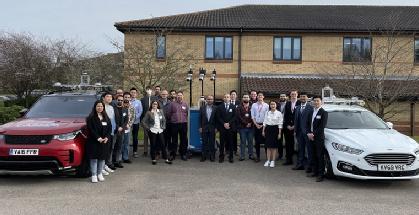 Working in partnership with Jaguar Land Rover, TRL and the University of Surrey, researchers from the Intelligent Vehicles directorate at WMG, University of Warwick have implemented a Proof of Concept demonstrator. This demonstrator focusses on unleashing the power of Edge and Cloud Computing, using a “connected roundabout” at the University of Warwick’s main campus.
Working in partnership with Jaguar Land Rover, TRL and the University of Surrey, researchers from the Intelligent Vehicles directorate at WMG, University of Warwick have implemented a Proof of Concept demonstrator. This demonstrator focusses on unleashing the power of Edge and Cloud Computing, using a “connected roundabout” at the University of Warwick’s main campus.
The Cloud Assisted Real-time Methods for Autonomy (CARMA) project, is part of the £11m TASCC programme funded by the Engineering and Physical Sciences Research Council (EPSRC) and Jaguar Land Rover. Supported by WMG’s Centre High Value Manufacturing Catapult, the CARMA project was established with the intention to create secure and resilient cloud-based platforms to enable safe and robust semi-autonomous functions on future cars in the short term, and with the vision of achieving fully autonomous vehicles.
Professor Mehrdad Dianati, Head of Intelligent Vehicles Research at WMG, University of Warwick said: “We expect autonomous vehicles to be much safer, much more efficient and much more comfortable than human driven vehicles. Unfortunately, with existing sensor and computing technologies, it is difficult and expensive to achieve the level of accuracy and reliability of the perception of the environment that’s expected.”
“CARMA not only demonstrates how these concepts could be implemented in practice, but also highlights what the impact of such technologies might be. This research will help manufacturers, technology developers, policy makers and road operators to make informed decisions on how they will adopt technologies in future road infrastructure, regulations, products and services.”
CARMA researchers installed eight infrastructure cameras, as off-board sensors, at the roundabout to monitor the environment and stream video to a base station called ‘Edge’. Using two-way communication, the Edge processes its own live information with information received from nearby connected vehicles. This processed data containing object, traffic, road layout and lane availability information is broadcast and received by the vehicles.
Dr Graham Lee, Principal Engineer at WMG, University of Warwick, added: “At complex road junctions, the CARMA platform can help enable on-road autonomy by providing additional real time data about the environment through the use of off-board sensors and computing. This gives vehicles the ability to navigate complex road junctions safely and efficiently.”
Dr Saber Fallah, Director of the Connected Autonomous Research Lab at the University of Surrey commented: “This technology enables new business models for the transportation system in alignment with the rise of shared mobility. In addition, autonomous vehicle technology also highlights the potential for how elderly people or disabled people can benefit from the joy of driving from point A to point B safely.”
The testing infrastructure was supported by the Midlands Future Mobility project, Innovate UK and the Centre for Connected and Autonomous Vehicles of the UK Government. The Open Innovation Platform research vehicle used within the project was developed with support from the High Value Manufacturing Catapult and used alongside the CARMA research vehicle provided by JLR.
Over ten follow-on projects have been inspired by CARMA, as technological, regulatory and business challenges are to be overcome before the concept can be deployed on a mass scale. Through the project 23 early career scientists and engineers were trained and three patents were granted along with 40 publications on the work carried out.

